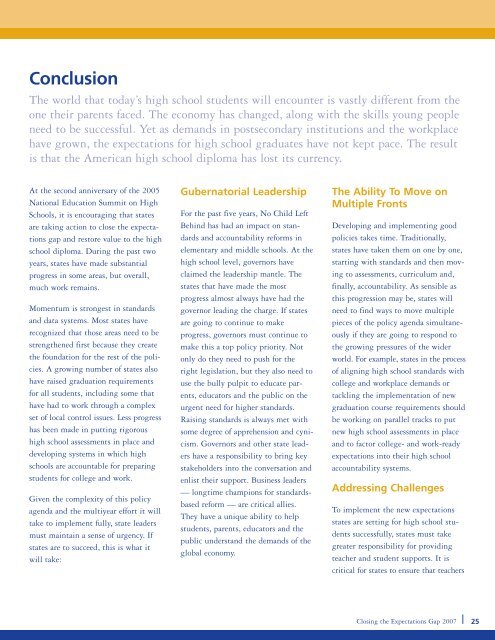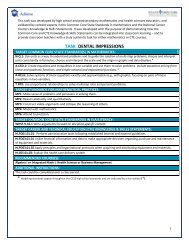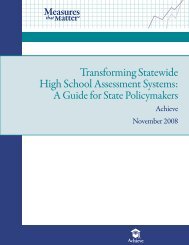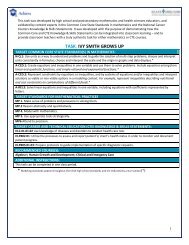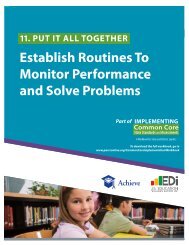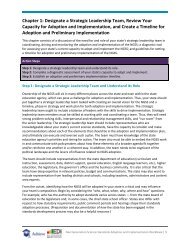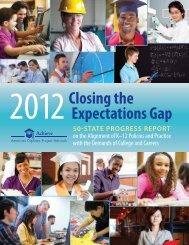Closing the Expectations Gap 2007 - Achieve
Closing the Expectations Gap 2007 - Achieve
Closing the Expectations Gap 2007 - Achieve
You also want an ePaper? Increase the reach of your titles
YUMPU automatically turns print PDFs into web optimized ePapers that Google loves.
ConclusionThe world that today’s high school students will encounter is vastly different from <strong>the</strong>one <strong>the</strong>ir parents faced. The economy has changed, along with <strong>the</strong> skills young peopleneed to be successful. Yet as demands in postsecondary institutions and <strong>the</strong> workplacehave grown, <strong>the</strong> expectations for high school graduates have not kept pace. The resultis that <strong>the</strong> American high school diploma has lost its currency.At <strong>the</strong> second anniversary of <strong>the</strong> 2005National Education Summit on HighSchools, it is encouraging that statesare taking action to close <strong>the</strong> expectationsgap and restore value to <strong>the</strong> highschool diploma. During <strong>the</strong> past twoyears, states have made substantialprogress in some areas, but overall,much work remains.Momentum is strongest in standardsand data systems. Most states haverecognized that those areas need to bestreng<strong>the</strong>ned first because <strong>the</strong>y create<strong>the</strong> foundation for <strong>the</strong> rest of <strong>the</strong> policies.A growing number of states alsohave raised graduation requirementsfor all students, including some thathave had to work through a complexset of local control issues. Less progresshas been made in putting rigoroushigh school assessments in place anddeveloping systems in which highschools are accountable for preparingstudents for college and work.Given <strong>the</strong> complexity of this policyagenda and <strong>the</strong> multiyear effort it willtake to implement fully, state leadersmust maintain a sense of urgency. Ifstates are to succeed, this is what itwill take:Gubernatorial LeadershipFor <strong>the</strong> past five years, No Child LeftBehind has had an impact on standardsand accountability reforms inelementary and middle schools. At <strong>the</strong>high school level, governors haveclaimed <strong>the</strong> leadership mantle. Thestates that have made <strong>the</strong> mostprogress almost always have had <strong>the</strong>governor leading <strong>the</strong> charge. If statesare going to continue to makeprogress, governors must continue tomake this a top policy priority. Notonly do <strong>the</strong>y need to push for <strong>the</strong>right legislation, but <strong>the</strong>y also need touse <strong>the</strong> bully pulpit to educate parents,educators and <strong>the</strong> public on <strong>the</strong>urgent need for higher standards.Raising standards is always met withsome degree of apprehension and cynicism.Governors and o<strong>the</strong>r state leadershave a responsibility to bring keystakeholders into <strong>the</strong> conversation andenlist <strong>the</strong>ir support. Business leaders— longtime champions for standardsbasedreform — are critical allies.They have a unique ability to helpstudents, parents, educators and <strong>the</strong>public understand <strong>the</strong> demands of <strong>the</strong>global economy.The Ability To Move onMultiple FrontsDeveloping and implementing goodpolicies takes time. Traditionally,states have taken <strong>the</strong>m on one by one,starting with standards and <strong>the</strong>n movingto assessments, curriculum and,finally, accountability. As sensible asthis progression may be, states willneed to find ways to move multiplepieces of <strong>the</strong> policy agenda simultaneouslyif <strong>the</strong>y are going to respond to<strong>the</strong> growing pressures of <strong>the</strong> widerworld. For example, states in <strong>the</strong> processof aligning high school standards withcollege and workplace demands ortackling <strong>the</strong> implementation of newgraduation course requirements shouldbe working on parallel tracks to putnew high school assessments in placeand to factor college- and work-readyexpectations into <strong>the</strong>ir high schoolaccountability systems.Addressing ChallengesTo implement <strong>the</strong> new expectationsstates are setting for high school studentssuccessfully, states must takegreater responsibility for providingteacher and student supports. It iscritical for states to ensure that teachers<strong>Closing</strong> <strong>the</strong> <strong>Expectations</strong> <strong>Gap</strong> <strong>2007</strong> 25


